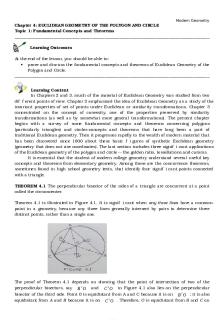Topic 1 Lecture 4 PDF

| Title | Topic 1 Lecture 4 |
|---|---|
| Author | Anonymous User |
| Course | MRI Physics I |
| Institution | Northern Alberta Institute of Technology |
| Pages | 4 |
| File Size | 380.4 KB |
| File Type | |
| Total Downloads | 23 |
| Total Views | 160 |
Summary
Topic one video lecture 4...
Description
PHYS 1110: MRI PHYSICS I TOPIC 1: BASIC MATHEMATICAL CALCULATIONS Lecture 4: Exponential Growth and Decay Exponential Functions An exponential function has the property that the value of the function always increases/decreases by the same factor in a given time interval. (eg. radioactive decay) Example:
The number of bacteria in a culture doubles in number every 30 minutes. Or consider a chessboard. A penny is placed on one of the squares and the penny’s number is doubled in the subsequent squares. This illustrates exponential functions as exponential growth where it’s extremely rapid when given enough time. It does not seem like the number is going up as high at the beginning but looking at the last square, there will be lots of penies.
Exponential functions can grow very rapidly if they’re allowed to. Example:
A particular investment returns an annual rate of growth of 10%. Suppose your initial investment is $1000. Plot the growth of investment over 20 years.
Now let’s make a simple graph based on the information above. Amount of money on the y-axis, time on the x-axis.
Initially the numbers grow slowly. All exponential functions have this basic behaviour where they start off slowly but then curve rapidly increases. If we were to continue this, you would see that the curve takes on a shape of:
The general formula for exponential growth is:
A = Initial amount at t = 0; amount at the start of the problem. B = “Base” of the exponential function. The factor by which the quantity grows/shrinks in a given time interval. T = “Time Constant”, the interval of time in which the function grows by a factor equal to the base. t = Elapsed time Make sure the time units are always the same!!! In general mathematical terms, an exponential function has the form:
This is not the same as:
Power function is when the base is the variable.
Example:
A student invests $5000 in an investment which pays 4½% annually. If the interest is calculated monthly, determine the value of the account after 5 years.
(Note for b: We have to account for the amount we had at the beginning of the compounding period, so we add this number to 1. b = 1.00375.)
Exponential Decay In addition to exponential growth, you can have exponential decay. A particular quantity will decrease by the same factor at a given time interval. (eg. radioactive decay) Example:
Radon has a half-life of 5.52 days. Suppose the concentration of radon at the time zero is 100 ppm (parts per million). Plot the concentration of radon over a period of 22 days.
As you can see, the exponential decay curve decreases rapidly then kind of levels out. It is important to realize that the concentration never goes to zero theoretically. This curve asymptotically approaches the t-axis (x-axis) but never actually reaches it. The general formula for exponential decay is:
The formula is very similar but the only difference is that the base will be less than one because for exponential decay, the amount decreases by a certain factor in a given time interval. Example:
Technetium-99m has a half-life of 6.02 hours. If the original activity of Tc-99 was 150 M Bq, find the activity after 18.06 hours and 2652 hours. (becquerel being the SI unit of activity)
First part of question:
(Note: Why b = 2. Since this is radioactive decay, in a time equal to half life, the quantity decreases by a factor of one half.)
Easier way to do the problem rather than using the full equation:
Of course, if your time is not a whole number multiple of the half life, then this equation does not work. Second part of question:...
Similar Free PDFs

Topic 1 Lecture 4
- 4 Pages

Topic 4 - lecture notes
- 6 Pages

Topic 2 Lecture 1
- 4 Pages

Topic 4. Lecture EL Filibusterismo
- 14 Pages

Topic 1 Lecture Slide
- 140 Pages

Topic 4 review - Lecture notes 4
- 3 Pages

Term 1 Topic 2- Lecture
- 5 Pages

LIFM Topic 1-4 Revision
- 7 Pages

Chapter 4 Topic 1 Module
- 6 Pages

Topic-1-4 - Advance Accounting
- 6 Pages

Topic 4
- 7 Pages

Topic 4
- 8 Pages

Topic 4
- 11 Pages

Copy of Topic 4 test - Lecture notes
- 10 Pages

NE Topic 1 - Lecture notes 1
- 5 Pages
Popular Institutions
- Tinajero National High School - Annex
- Politeknik Caltex Riau
- Yokohama City University
- SGT University
- University of Al-Qadisiyah
- Divine Word College of Vigan
- Techniek College Rotterdam
- Universidade de Santiago
- Universiti Teknologi MARA Cawangan Johor Kampus Pasir Gudang
- Poltekkes Kemenkes Yogyakarta
- Baguio City National High School
- Colegio san marcos
- preparatoria uno
- Centro de Bachillerato Tecnológico Industrial y de Servicios No. 107
- Dalian Maritime University
- Quang Trung Secondary School
- Colegio Tecnológico en Informática
- Corporación Regional de Educación Superior
- Grupo CEDVA
- Dar Al Uloom University
- Centro de Estudios Preuniversitarios de la Universidad Nacional de Ingeniería
- 上智大学
- Aakash International School, Nuna Majara
- San Felipe Neri Catholic School
- Kang Chiao International School - New Taipei City
- Misamis Occidental National High School
- Institución Educativa Escuela Normal Juan Ladrilleros
- Kolehiyo ng Pantukan
- Batanes State College
- Instituto Continental
- Sekolah Menengah Kejuruan Kesehatan Kaltara (Tarakan)
- Colegio de La Inmaculada Concepcion - Cebu
